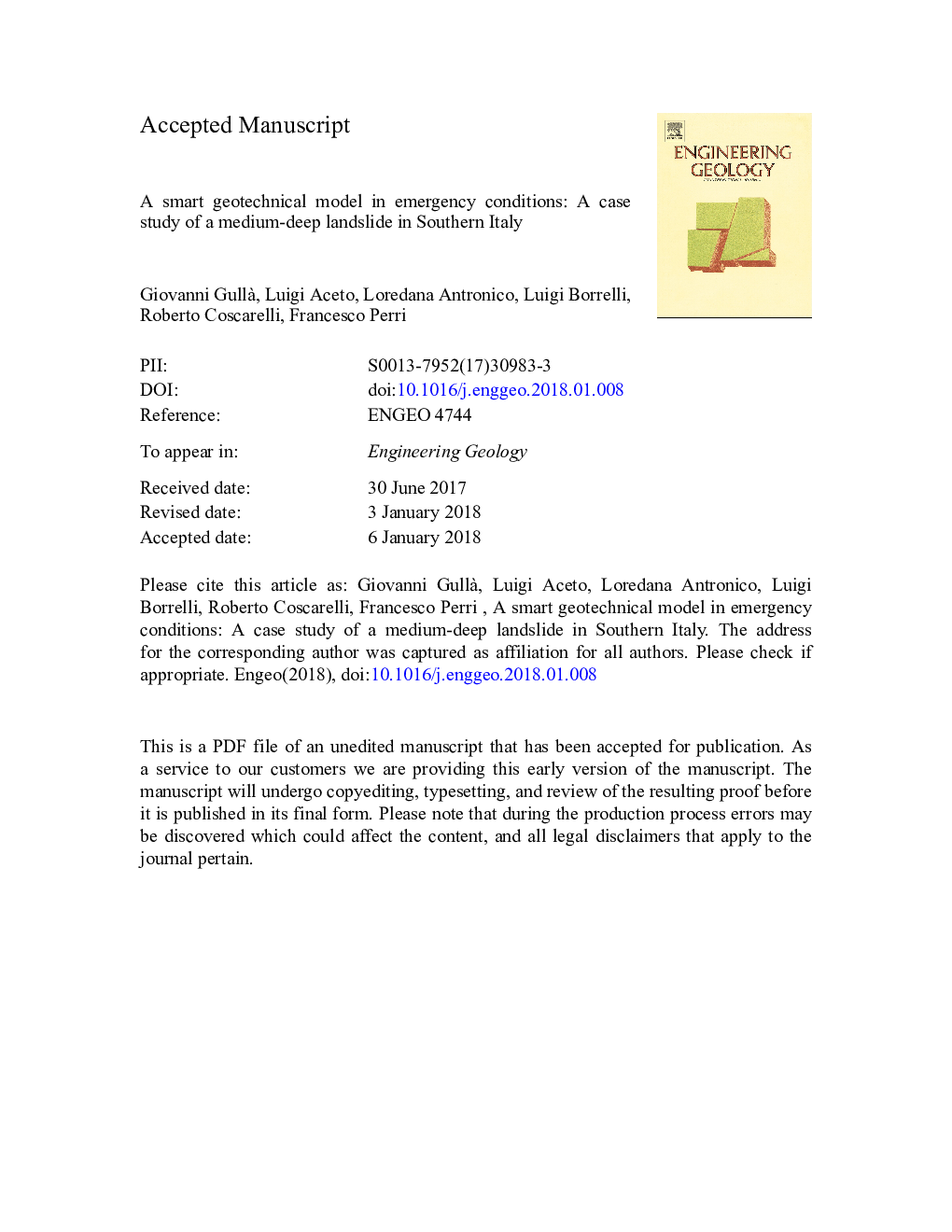| کد مقاله | کد نشریه | سال انتشار | مقاله انگلیسی | نسخه تمام متن |
|---|---|---|---|---|
| 8915964 | 1641751 | 2018 | 34 صفحه PDF | دانلود رایگان |
عنوان انگلیسی مقاله ISI
A smart geotechnical model in emergency conditions: A case study of a medium-deep landslide in Southern Italy
ترجمه فارسی عنوان
یک مدل ژئوتکنیکی هوشمند در شرایط اضطراری: یک مطالعه موردی یک زمینی لغزش متوسط در جنوب ایتالیا
دانلود مقاله + سفارش ترجمه
دانلود مقاله ISI انگلیسی
رایگان برای ایرانیان
کلمات کلیدی
زمین لغزش متوسط مدل ژئوتکنیک، شرایط اضطراری، جنوب ایتالیا،
ترجمه چکیده
شکست های شیب در نتیجه عوامل مختلفی هستند (شرایط جغرافیایی ساختاری و مورفولوژیکی، توپوگرافی، ویژگی های ژئوتکنیکی و غیره). در یک فاز عادی، یک تحلیل ثانویه شیب معمولی، شناسایی عوامل است که می تواند شکاف شیب، مکانیسم های آن، مدل سازی شرایط ثبات و ارزیابی آنها را در شرایط بحرانی ایجاد کند. برای تعیین عوامل مستعد کننده و تحریک کننده، نظارت یکپارچه یک ابزار ضروری و قدرتمند است. در این مقاله، با اشاره به مطالعه موردی یک لغزش عمیق متوسط که در زمستان سال 2009-2010 در کالابریا (جنوب ایتالیا) رخ داده است، روش و ابزار تعریف مدل ژئوتکنیکی اضطراری (مدل ژئوتکنیکی هوشمند) با استفاده از یک مدل زمین شناسی پیشنهاد می شود. تعریف هر دو مدل منابع را که در شرایط اضطراری و زمان کوتاه در دسترس برای رسیدن به اهداف (حفاظت از امنیت عمومی و خصوصی، بازسازی شرایط عادی و غیره) به دست می آید، در نظر می گیرد. روش پیشنهادی به منظور دستیابی منظم و منظم در شرایط اضطراری، داده هایی را که برای مدیریت یک وضعیت خاص و برای تعریف وضعیت شناختی اولیه از مشکل مفید هستند، فراهم می کند. این عناصر می تواند به طور خاص در هر دو حالت اضطراری (مدیریت خطر با استفاده از دانش کمی دانش) و شرایط عادی برای برنامه ریزی، طراحی، تحقق بخشیدن و مدیریت اقدامات قطعی برای انطباق، کاهش و کاهش خطر، بسیار موثر باشد. علاوه بر این، دانش همان می تواند ارجاعات مفیدی را برای تشخیص زمین لغزش هایی که در محیط های جغرافیایی محیطی مشابه رخ می دهد، ارائه دهد.
موضوعات مرتبط
مهندسی و علوم پایه
علوم زمین و سیارات
مهندسی ژئوتکنیک و زمین شناسی مهندسی
چکیده انگلیسی
Slope failures are the result of various predisposing factors (geo-structural and morphological conditions, topography, geotechnical characteristics, etc.). In an ordinary phase, a typical slope stability analysis includes the identification of factors that can trigger a slope failure, its mechanisms, the modelling of stability conditions and their assessment during critical situations. To define the predisposing and triggering factors, integrated monitoring represents an essential and powerful tool. In this paper, referring to the case study of a medium-deep landslide that occurred in Calabria (Southern Italy) during the winter of 2009-2010, a method and means of defining an emergency geotechnical model (smart geotechnical model) using a geological model are proposed. The definition of both models considers the resources that may be obtained in an emergency and the short time available to achieve the objectives (protection of public and private safety, restoration of normal conditions, etc.). The proposed method allows the orderly and systematic acquisition, under emergency conditions, of data that are useful for the management of a particular situation and for defining an initial cognitive state of the problem. These elements can be particularly effective in both emergency (to manage risk using progressively quantitative knowledge) and ordinary conditions to plan, design, realize and manage definitive measures for risk adaptation, mitigation and reduction. Moreover, the same knowledge can provide useful references to typify landslides that occur in similar geo-environmental contexts.
ناشر
Database: Elsevier - ScienceDirect (ساینس دایرکت)
Journal: Engineering Geology - Volume 234, 21 February 2018, Pages 138-152
Journal: Engineering Geology - Volume 234, 21 February 2018, Pages 138-152
نویسندگان
Giovanni Gullà , Luigi Aceto, Loredana Antronico, Luigi Borrelli, Roberto Coscarelli, Francesco Perri,
